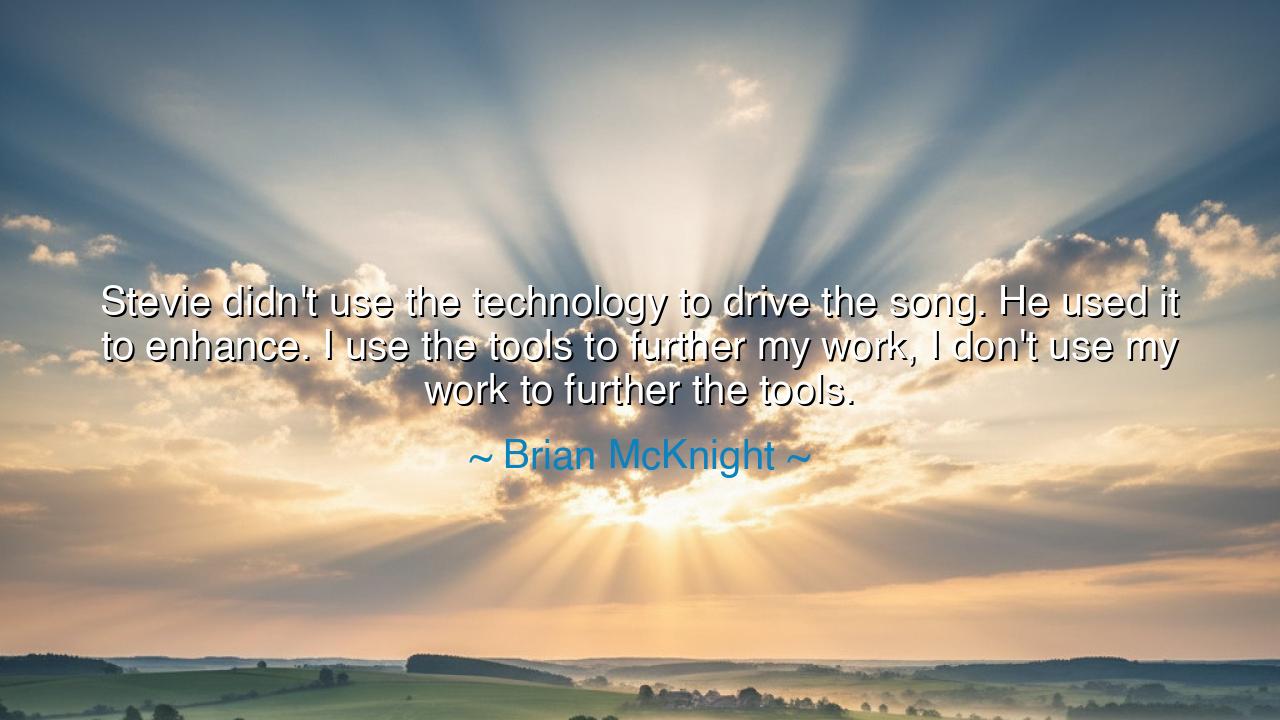
Stevie didn't use the technology to drive the song. He used it
Stevie didn't use the technology to drive the song. He used it to enhance. I use the tools to further my work, I don't use my work to further the tools.






The words of Brian McKnight, “Stevie didn't use the technology to drive the song. He used it to enhance. I use the tools to further my work, I don't use my work to further the tools,” resonate as a meditation on mastery, purpose, and the delicate relationship between art and technology. McKnight speaks not merely of musical instruments, synthesizers, or recording devices, but of the philosophy that underpins creation. True artistry, he asserts, arises when tools serve the vision, not when the vision bends to accommodate the tools. Technology is a servant, not a master.
The origin of this insight lies in McKnight’s career as a singer, songwriter, and musician deeply inspired by Stevie Wonder. Wonder, a master of musical innovation, famously employed technology—synthesizers, drum machines, and electronic instruments—not to overshadow the song, but to amplify its soul, its emotion, and its narrative. McKnight reflects on this approach as a guiding principle: the creative work itself must remain central, with technology serving to reveal and enrich its power.
History provides ample illustration of this wisdom. Consider the innovations of Leonardo da Vinci, who employed newly designed tools to explore anatomy, flight, and perspective. The tools—sketching devices, models, and mechanical instruments—were never the purpose; they were the means to better understand and depict the world. Da Vinci’s genius lies not in his instruments but in his vision, and his instruments magnified that vision. McKnight’s philosophy mirrors this ancient truth: tools are extensions of the mind and heart, not ends unto themselves.
Even within music, the lesson is clear. The invention of the electric guitar did not create rock ‘n’ roll; it allowed musicians to express energy and emotion in new ways. Legends like Jimi Hendrix and B.B. King used the instrument to enhance their voice, their story, and their presence, not to showcase the guitar itself. McKnight’s observation echoes this principle: artistry flourishes when technology complements the human spirit, rather than replacing it or dominating it.
The meaning of McKnight’s words extends beyond music to all forms of creative endeavor. Technology—from computers to cameras to scientific instruments—is only as meaningful as the purpose it serves. To allow tools to dictate the work is to invert the natural order of creativity; to use tools to serve the work is to honor the spirit of mastery. In this balance lies the secret of enduring artistry and meaningful innovation.
The lesson is profound: prioritize vision over mechanism, substance over style. Whether in art, science, or leadership, allow the essence of your work to guide the use of your instruments. McKnight teaches that tools are amplifiers, not drivers; they exist to empower your expression, not to define it. When mastered in this spirit, technology becomes a bridge to greater clarity, impact, and emotional resonance.
Practical action emerges naturally. In your craft, identify the tools at your disposal and examine whether they enhance your purpose or distract from it. Experiment with technology thoughtfully, ensuring that each addition strengthens rather than overwhelms your work. Study the masters in your field, observing how they wield instruments to serve their vision, and apply the same discernment to your practice.
Thus, let Brian McKnight’s words echo as a principle for generations: use tools to enhance the work, not to drive it. Technology, in any form, achieves its highest value when it elevates human expression, amplifies creativity, and reveals the power of vision. By honoring the work first and the tools second, we ensure that every creation—whether song, painting, or invention—speaks with clarity, soul, and enduring resonance.






AAdministratorAdministrator
Welcome, honored guests. Please leave a comment, we will respond soon